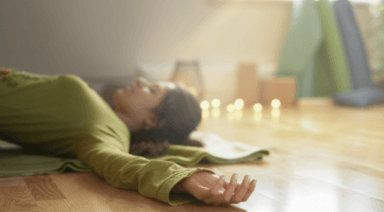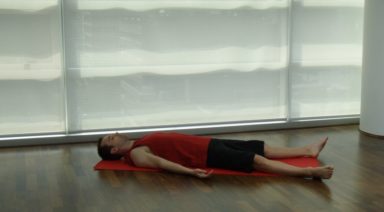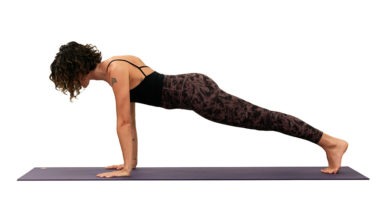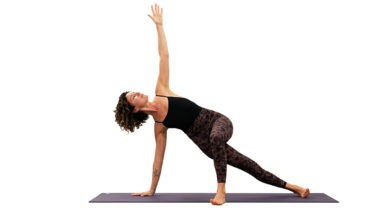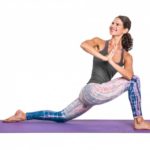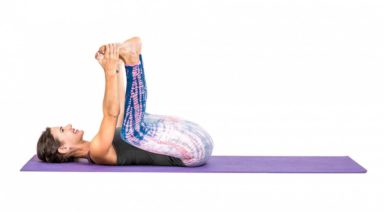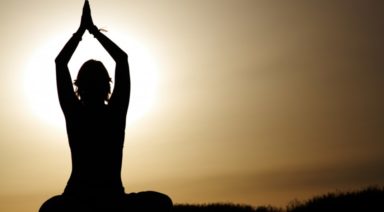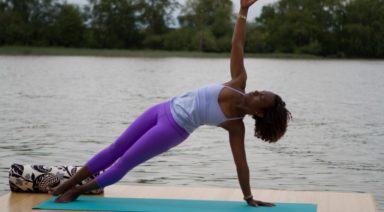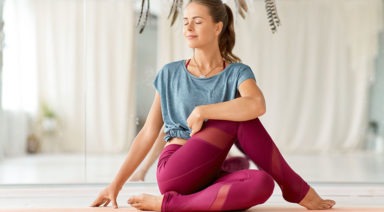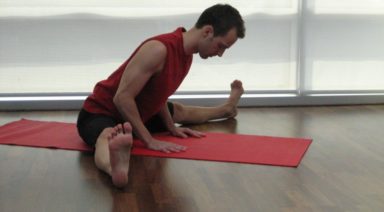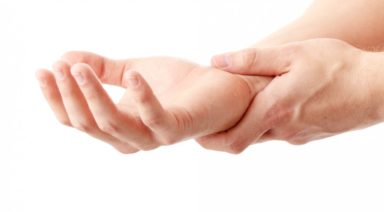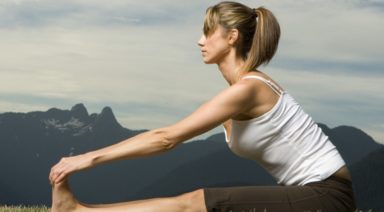9 Yoga Poses for Relieving Shoulder Tension

Yoga, when practiced regularly, relaxes muscle tension and in the process, also strengthens the relaxed muscles. Here are a list of poses that will help relieve tension around the shoulder area:

1. BALASANA (CHILD’S POSE)
Child’s pose is a very good way to start a practice. It’s also an excellent rest pose during a vigorous flow.
Come to your hands and knees, press your hips back into your heels. Open your knees out toward the corner of your mat and rest your belly and chest between your thighs; arms out in front of you and palms up. Allow your shoulders to melt downward. This is a gentle way to start warming up the shoulders.
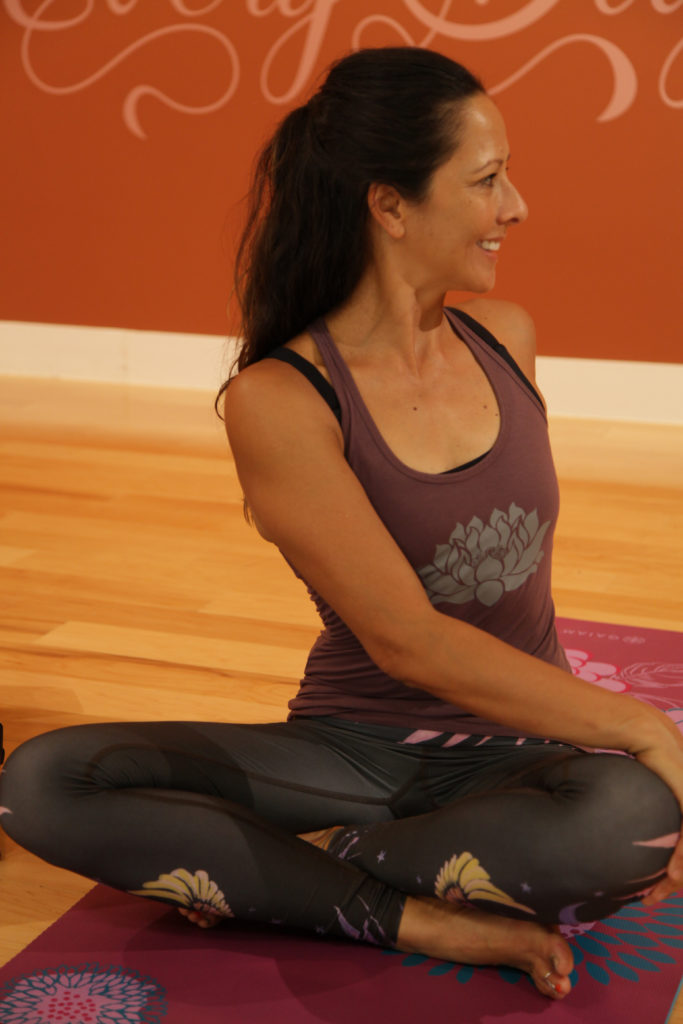
2. BHARADVAJASANA I (SEATED TWIST)
Sitting crossed legged, stretching your spine tall, place your left hand on your right knee and your right arm on the floor at your right hip. Draw a breath in and turn your shoulders and upper torso to the right.
The idea here is to stay gently grounded in the sits bones while extending the spine upward. If you’re twisting right, then ensure your left hip stays grounded. Lift as you inhale and turn as you exhale. Keep your gaze over your right shoulder. Try to keep your shoulders at the same height, and keep your neck soft. Your chin should be in neutral, but if you want an added stretch, you can tuck the chin. Hold for a few breaths, and then come back to center. Repeat on the left side.

3. SUPTA BADDHA KONASANA (RECLINING BOUND ANGLE POSE)
This pose offers a stretch across the chest and releases the shoulders.
Lying on your back, put a bolster or a block longways between your shoulder blades. Bring the soles of your feet together and allow your knees to fall open. If that is too intense, just leave the legs long and resting on the mat. Rest your arms by your sides. You will notice that if you turn your palms to face up, that will increase the rotation in the shoulders. You can either support your head or, if it feels good, allow your head to drop back (this will stimulate the thyroid).
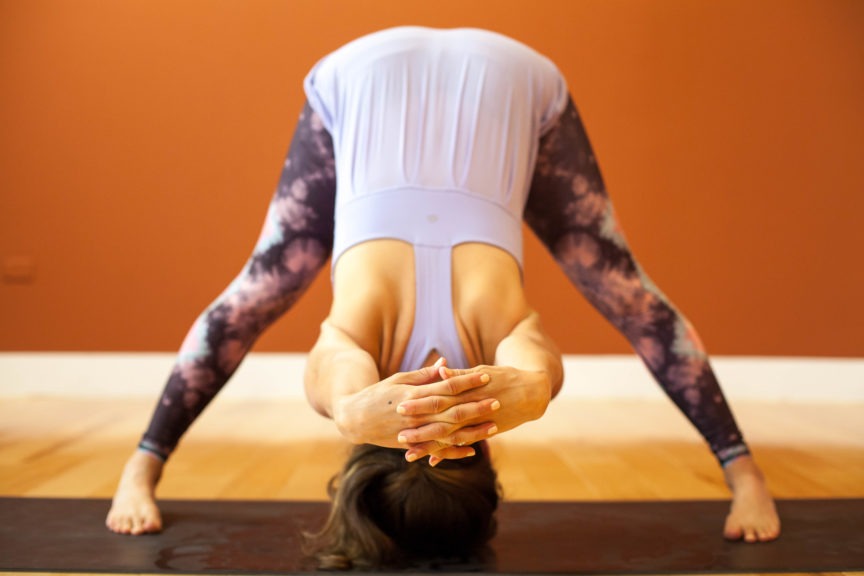
4. PRASARITA PADOTTANASANA (WIDE-LEGGED FORWARD FOLD)
Standing with your legs wide, turn your toes inward slightly and heels out. Bring your hands to meet behind your back and interlace your fingers. If that is not accessible to you, hold a towel or a strap between your hands. With an inhale, lift your chest and roll your shoulders back, extending the hands backward. On the exhale bend forward, keeping a slight bend in your knees. Allow gravity to draw your hands over your head. This creates a lovely rotation in the shoulders. Hold this pose for at least eight breaths (inhales and exhales).

5. SETU BANDHASANA (BRIDGE POSE)
Lie down on your back and bend your knees, feet hip width apart and on the mat. As you breathe out, press your feet into the mat and raise your buttocks, lifting the sternum towards the chin. Elongate the back of the neck onto the floor and breathe deeply. Reach for your feet with your hands, while rolling on to your shoulders. Keep your head still with your nose pointing up and gently press the back of your head into the mat, all the while lifting the hips.
You have the option of supporting yourself with your hands under your hips, or on a block. As you breathe, and your body starts to open, try to walk your shoulders closer to each other and reach your hands towards your feet. This will help open the chest. Move your chest toward your chin. This pose is also great for calming the mind.

6. PASCHIMOTTANASANA (SUPPORTED FORWARD BEND)
This pose is meant to release and relax your neck. Sit on the floor in front of a chair. Place a pillow on the chair, and rest your head on the pillow with your arms just under your forehead. Gently stretch the neck muscles by dropping the chin to the chest. Breathe in and out while resting your head on the pillow.

7. GOMUKHASANA (COW FACE POSE)
When we sit in front of a computer we round our shoulders and push our chins forward. This pose is great for helping to correct our posture.
Sit up straight in a comfortable cross-legged seat. Lift your left arm straight up, palm turned inward and thumb pointing to the back of the room. Bend that arm and reach it down between the shoulder blades. Now extend your right arm to the side, thumb down and palm facing back. Bend the arm and bring the elbow in to the side and reach up between the shoulder blades. Take hold of the other hand. If this is a little hard, use a strap between the hands. Lift your heart and press into your sits bones. Keep your chin in neutral and the neck soft.

8. SAVASANA (CORPSE POSE)
This pose is often used in meditation with the intention of complete relaxation.
Lie on your back, arms by your sides. Spread your feet apart and allow them to drop open. Let your arms rest by your sides, palms up. Allow your fingers to curl up naturally. Lift your shoulders, broaden them and then let them melt into the mat as you exhale. Breathe with deep, smooth breaths.
Support your body where you need to. Sometimes a bolster under the knees, or between the shoulder blades feels good.

9. YOGA OFF THE MAT
In a seated position, come to the top of your sits bones and gently draw your belly in. Lift your heart and allow your shoulders to slide down your back. Keep your chin in neutral and allow for a good distance between the ears and shoulders. This is also a good posture to hold when you are standing or walking. Keep the tailbone gently tucked under.
Remember to keep moving your body. It is joyful, gives us energy and keeps us healthy.
Try These Practices
Yoga for Insomnia

Not getting enough sleep or waking up in the middle of the night is the worst, except maybe not being able to get to sleep in the first place. Tossing and turning when all you want to do is catch some much needed zzzzzzzs is miserable. Lack of sleep can also increase risk of illness and decrease productivity. Roughly 60 million Americans are affected by chronic sleeplessness; women and people over the age of 65 are disproportionately impacted by this disorder.
There are a million reasons sleep can be elusive. Perhaps you have too much on your mind or maybe you are already anxious about everything you need to accomplish the next day. You also could be dealing with a more serious condition like insomnia. For a chronic problem, see your physician, but there are also some simple things you can do to combat occasional sleeplessness.
Insomnia runs in my family. If I have learned anything from my family members, it is that sleeplessness is more about getting your mind right and adjusting your daily habits and less about knocking yourself out with medication.
Why Yoga for Sleep?
According to Science Daily, “sometimes called the rest and digest system, the parasympathetic system conserves energy as it slows the heart rate, increases intestinal and gland activity, and relaxes sphincter muscles in the gastrointestinal tract”. The parasympathetic nervous system (PNS) is responsible for involuntary movement, which means you don’t always know when it is working and when it is struggling to keep up or is blocked. The PNS controls crying, salivation, urination, and digestion and works when it is at rest. Insomnia can dramatically decrease your PNS’s ability to function at full capacity.
Fortunately, the benefits of yoga, such as lowered stress, reduced blood pressure and better circulation, increase the activation of the PNS leading to better mental relaxation and better sleep.
One technique you may consider for preventing those sleepless nights is a regular yoga practice, especially gentle yoga in the evening. This is probably different from the yoga you practice in a studio. It is similar to restorative yoga in that it concentrates on low tension positions. Think of it more as stretching with a focus on your breath and calming your mind. If you find a few positions you really like, add them into your bedtime routine.
Relaxation is crucial to combatting insomnia. By focusing on your body, you are less likely to let your brain takeover and more likely to put aside the daily stressors to prepare for bedtime. In addition, yoga helps slow your breath, which should leave you feeling more calm. A few poses that are ideal for this include:
Child’s Pose – Balasana
Benefits
A common resting pose to regain control of your breath after a round of more challenging postures or movements, this position has virtues of its own when performed in isolation. It opens your hips, allows for better circulation, and most importantly, helps relax your mind.
Give it a Try
Begin in tabletop pose with your hands and knees on your mat. Your hands should be firmly below your shoulders and your knees below your hips. Next, sit back on your heels and spread your knees to the edges of your mat. While gently lowering your forehead to your mat, reach your hands at the top of your mat. Stay this way for several minutes. Focus on your breath. Breath in and out slowly. Concentrate on every inhale and exhale.
After a few minutes, spread you knees wider, which should sink your head lower into your mat. Stretch your arms farther up your mat and shift your focus to your fingertips. Fan out your fingers and press them into the mat. Remain here for several more minutes, then slowly lift your head and open your eyes. If that felt good, repeat two to three times before climbing into bed.
Supine Spinal Twist – Supta Matsyendrasana
Benefits
Opens your chest and stretches out your leg muscles. Alleviates pain in your lower back. Persistent back pain can often keep you tossing and turning at night.
Give it a Try
You can do this on a mat, soft carpet, or even in bed. Being by lying down on your back with your arms out to the sides, so that your body is in a “T” shape. As you inhale, lift your heels off the ground. Exhale and lower your heels back down, turning your knees to the left side of your body. Keep your knees stacked on top of each other.
Continue to focus on your breath, while turning your head to the right. Allow your right shoulder to press deeper into the mat maintaining the twist through the upper spine. Gently place one hand on top of your knees to deepen the stretch. Hold for at least 20 seconds, but feel free to stay in this position as long as you like, then repeat the stretch on the other side.
Legs Up The Wall Pose – Viparita Karani
Benefits
Lessens menstrual cramps and headaches, relives lower back pain and stress, and reduces the weight off the body which will help ease you into sleep.
Give it a Try
This position requires some set-up. First, grab two large blankets and a small towel/eye mask to put over your eyes. Fold one blanket in half and place it on top of your mat. Both your mat and the folded blanket should be along a wall so that your entire back will fit on top. Then, fold a second blanket thicker than the first and place to the side.
Lie on top of the first blanket with your seat against the wall and legs going up the wall. Place the folded blanket under your seat so that it elevates your seat and keeps your back on the ground. Your body should be in an “L” shape with the floor and the wall, if there is any space, gently shimmy your body forward so that you are making full contact with the wall.
Once your body is positioned, place the small towel/eye mask over your eyes and rest your arms along your sides. Allow your mind to empty. Focus on your breath and enjoy the sensations in your legs, as you stay in this position for about five minutes.
Cat-Cows – Chakravakasana
Benefits
This is a great position before bedtime if you spend most of your day sitting. Quickly builds heat and sheds extra energy to help you ease into sleep.
Give it a Try
Begin in tabletop position (same as Child’s Pose). Make sure your wrists are right under your shoulders and knees under your hips. Let go of any tension in your back and allow your spine to retain a neutral position.
Curl your toes under and tilt your pelvis back. Your seat should be raised, your back in a “U” shape and your gauze should be forward and slightly up towards the ceiling. You are now in the cow pose. Hold for a long exhale.
To transition into the cat pose, uncurl your feet so that your soles are facing up. Tip your pelvis forward and tuck your tailbone. Move your gauze down to your mat, allowing your head to follow and your spine to form an inverted “U.” Pull your navel into your spine and hold. Hold for a long inhale.
Inhale and exhale for several rounds. Remember to form a cat pose on inhale and a cow pose to exhale. Do this for at least three minutes, then rest in child’s pose. If you are still feeling restless, do two or three more rounds just like the first.
Happy Baby – Ananda Balasana
Benefits
Lubricates your joints, calms the mind, and releases tensions in the body.
Give it a Try
This is an easy, fun one. First, lie on your back on top of your mat. Hug your knees into your chest. Take 10-15 seconds in the pose to warm-up your body. Then, grab the soles of your feet (or ankles if grabbing your feet is impossible or uncomfortable). Using your hands, pull your legs apart and to the sides and hold the stretch for another 10-15 seconds. If it feels good, gently rock from left to right. Allow your head and shoulders to press deeper into the mat. Lastly, let go of your feet and return to hugging your knees. Repeat this exercise as many times as desired.
Pigeon Pose – Kapotasana
Benefits
Relieves tension in the chest and shoulders. Also, helps to relieve stress and anxiety.
Give it a Try
Begin the same way as Child’s Pose or Cat-Cows exercise – in tabletop pose with your hands and knees on your mat. Bring your right knee as far forward as it will go comfortably and slide slightly to the right of your body. Your toes should naturally tuck under your seat.
Shifting your focus to your left leg, slide your left leg as far back as possible. Make sure the soles of your feet face upwards. Place your hands on either side of your legs.
Then on exhale, extend your arms forward to the top of your mat, lay your torso down over your right leg, and lower your forehead onto your mat. Stay here for ten breaths. Then, deepen your stretch as much as possible by sinking into your hips and stay for another ten breaths.
Next Steps
You don’t have to resort to expensive, potential harmful prescription drugs to get a good night’s sleep. In addition to the pre-bedtime yoga positions suggested above, there are Ayurvedic sleep remedies and other natural techniques you can use to help you drift off to sleep and stay asleep, including:
- Routine. Routine. Routine. I can’t stress this enough. The simple act of doing your bedtime rituals in the same order can help remind your brain it is time to sleep. Make a list of what you typically do before bed and stick to it as much as possible.
- Your Bedroom. Is your sleeping space conducive to sleeping? If there are any lingering signs of work, get it out of there! Your bedroom should be exclusively used for two things. (I’ll let you read in between the lines on that one.)
- Relaxing Music can help you wind down. You want music that doesn’t have lyrics and won’t keep your mind racing.
- Scents can change your mood. I swear by an aromatherapy scent that I use before bedtime or anytime I am stressed. I have it in lotion, candles, and pillow spray.
- Write it down. Keeping a pen and paper on your nightstand can be an easy way to add things to your to-do and get them off your mind.
- More Yoga. There are other types of yoga that can be beneficial, including Kundalini Yoga and Yoga Nidra.
Yoga Nidra is one of my favorite things in the world. In fact, I treat myself to it for my birthday every year. It is essentially a yoga nap which will have you drifting off to sleep in no time.



